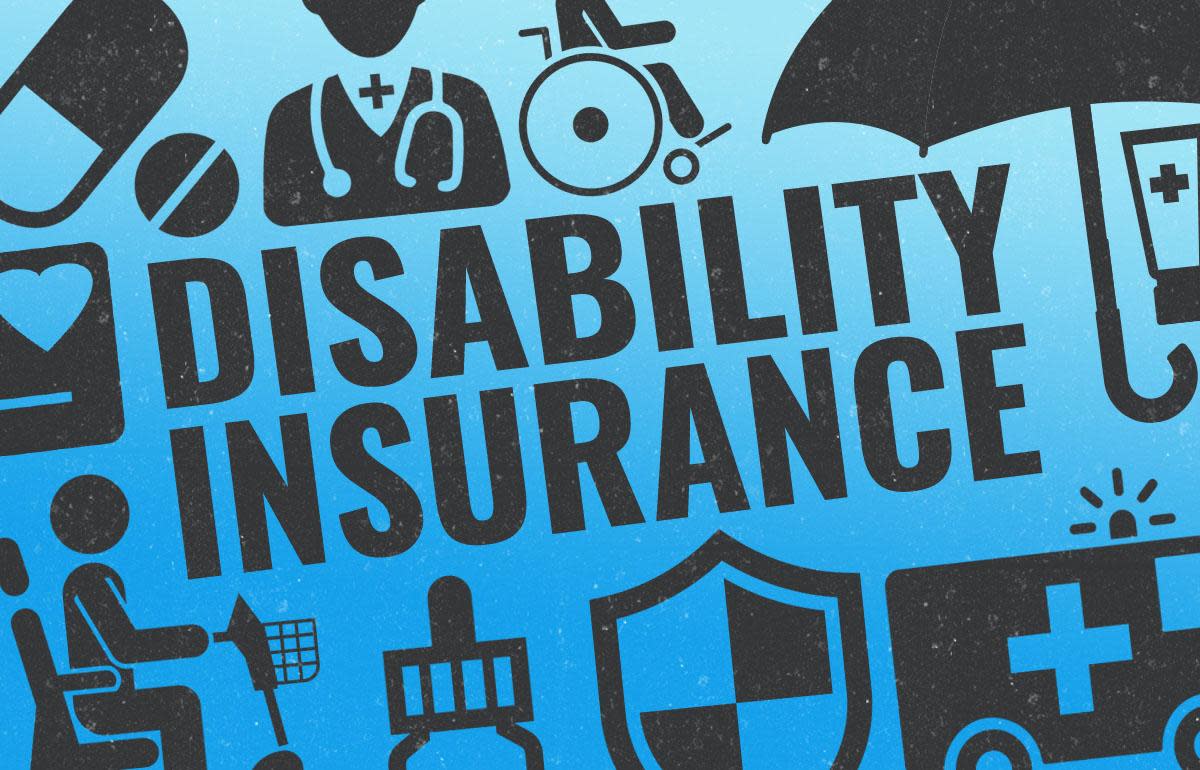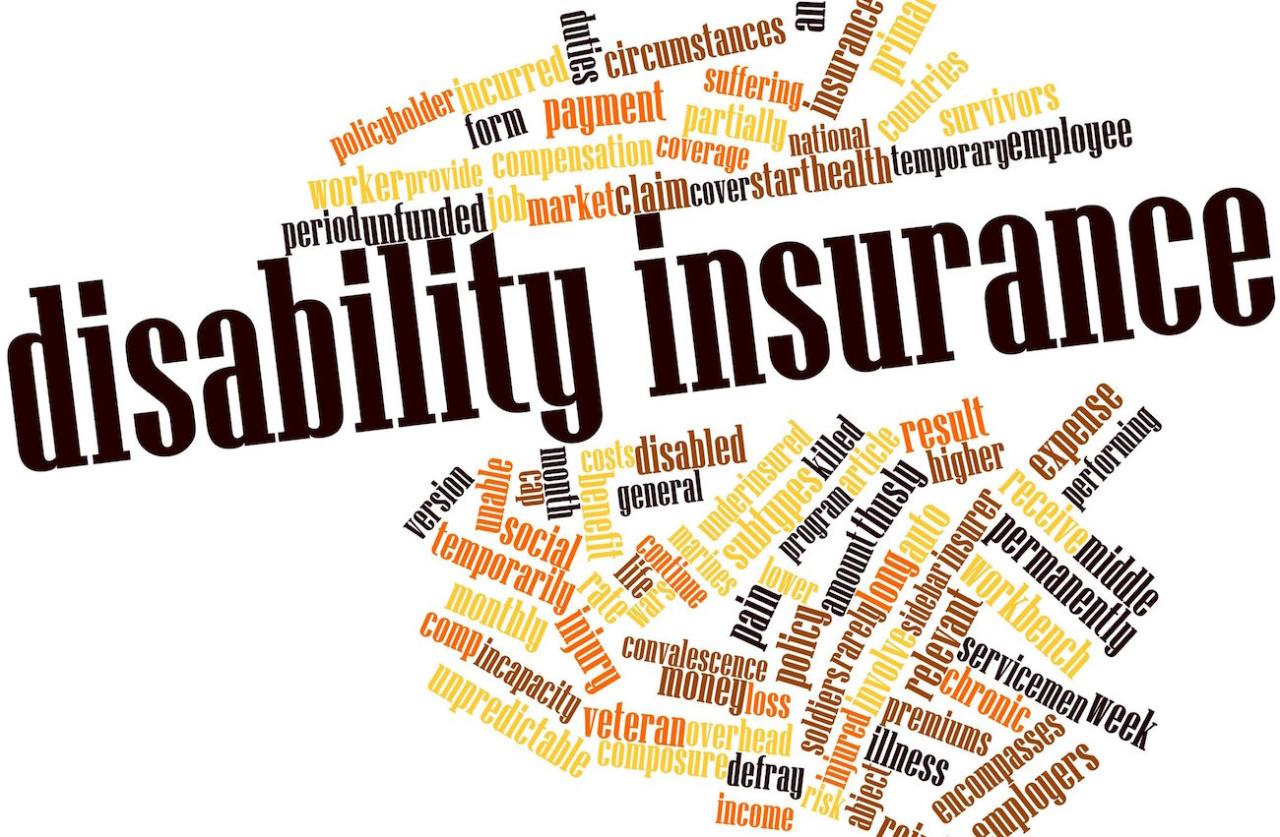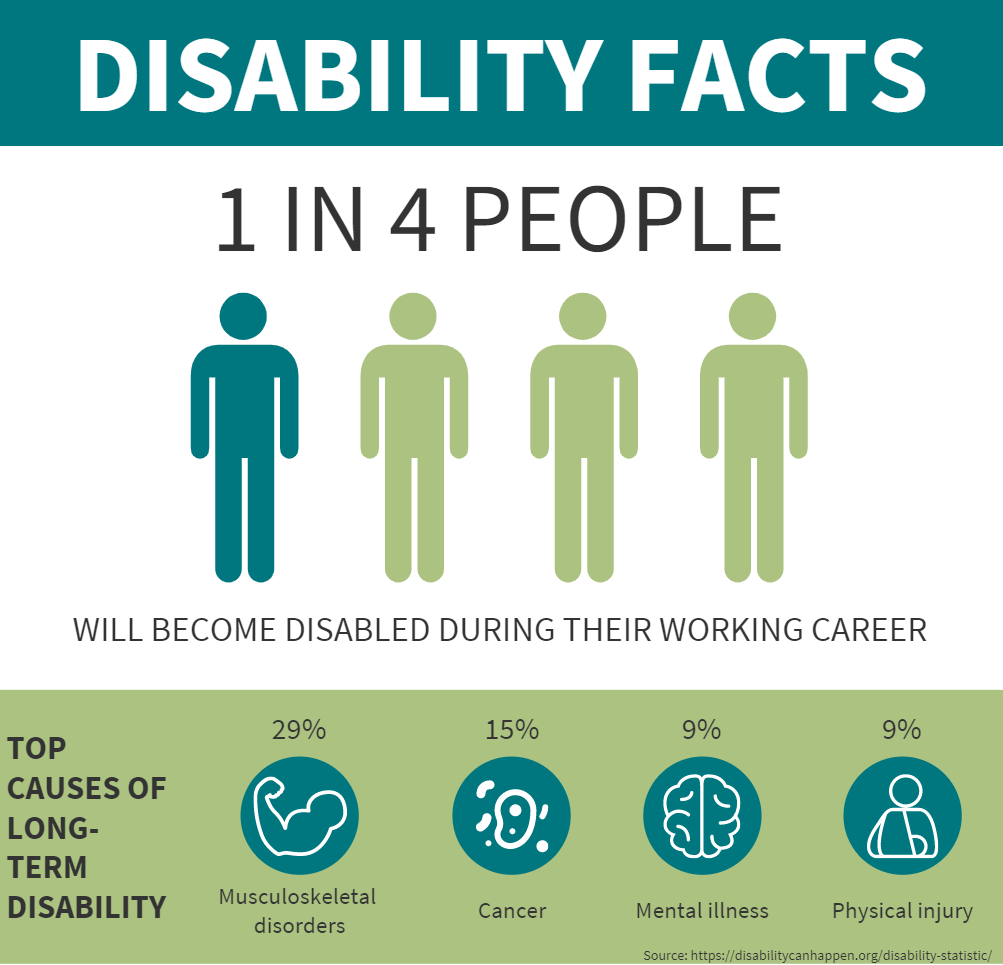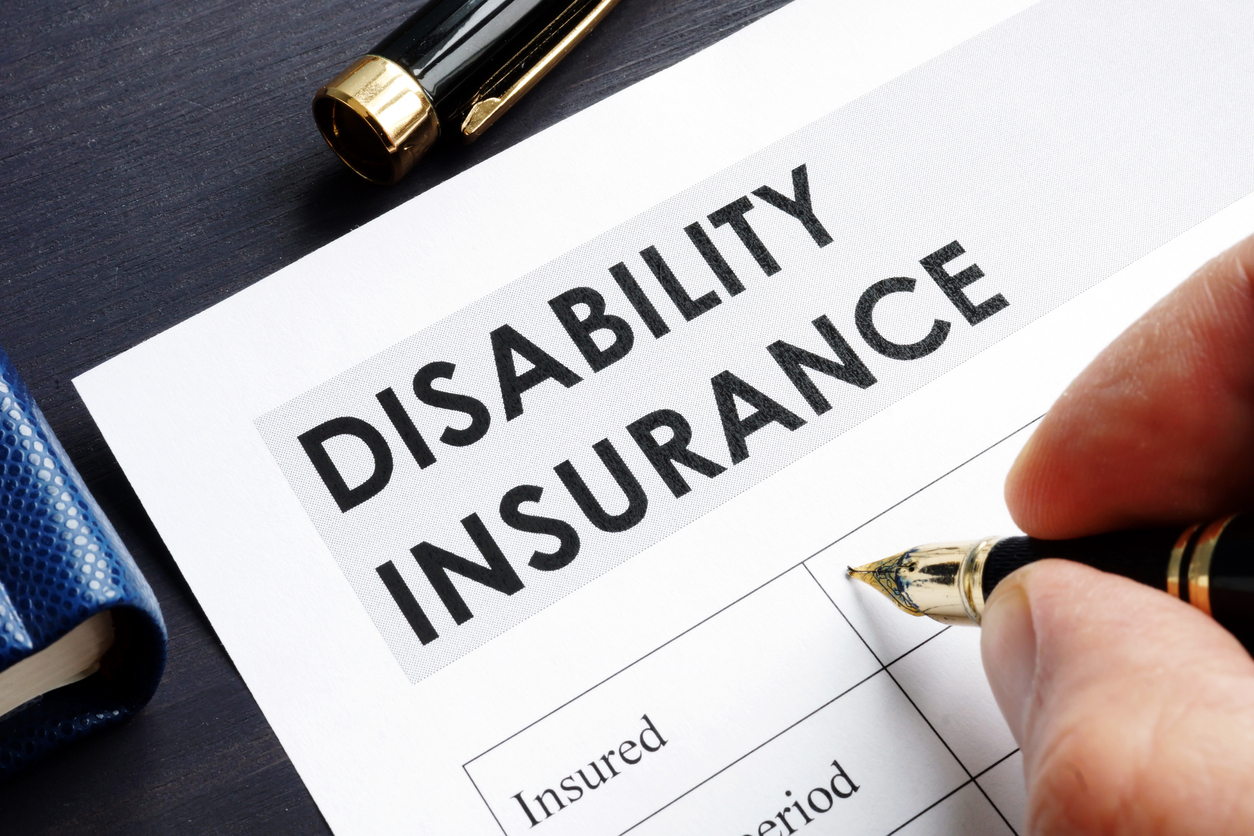The unexpected can strike at any moment, leaving individuals and families grappling with the financial and emotional consequences of disability. Disability insurance, often overlooked in the rush of daily life, stands as a vital safety net, offering financial security during times of unexpected illness or injury. This comprehensive guide delves into the intricacies of disability insurance, examining its various forms, key considerations, and the crucial role it plays in safeguarding your future.
From understanding the different types of coverage to navigating the claims process, we provide insights into the essential aspects of disability insurance. Whether you’re an individual seeking personal coverage or an employer exploring options for your workforce, this guide equips you with the knowledge to make informed decisions about this critical form of financial protection.
Understanding Disability Insurance

Disability insurance protects your income if you become unable to work due to an illness or injury. It can help you cover your expenses and maintain your standard of living during a time of financial vulnerability.
Types of Disability Insurance
Disability insurance can be categorized into different types based on the duration of coverage and the source of the policy.
- Short-term disability insurance provides coverage for a limited period, typically a few months, while you recover from a temporary illness or injury. It is often offered as a benefit by employers.
- Long-term disability insurance provides coverage for a longer period, often until you reach retirement age, for more severe illnesses or injuries that prevent you from working. It can be purchased individually or through an employer.
- Individual disability insurance is purchased directly from an insurance company and provides coverage tailored to your specific needs. It offers greater flexibility in terms of coverage and benefits, but it can also be more expensive.
- Group disability insurance is offered through an employer and typically provides coverage for a specific group of employees. It is often less expensive than individual policies, but it may have limitations on coverage and benefits.
How Disability Insurance Works
Disability insurance works by providing a monthly benefit payment to replace a portion of your lost income if you become disabled and unable to work. The amount of the benefit is determined by your policy’s coverage and your income level.
- Coverage: Disability insurance policies typically cover a range of disabilities, including illnesses, injuries, and mental health conditions. The specific conditions covered may vary depending on the policy. Some policies may have waiting periods, meaning you must be disabled for a certain amount of time before you can start receiving benefits.
- Benefits: Disability insurance benefits are typically paid as a percentage of your pre-disability income, up to a certain limit. The benefit period can range from a few months to a lifetime, depending on the policy.
- Limitations: Disability insurance policies often have limitations, such as exclusions for certain conditions or activities. For example, some policies may exclude coverage for pre-existing conditions or disabilities resulting from dangerous activities.
Common Disability Insurance Policies and Features
Here are some examples of common disability insurance policies and their features:
- Own Occupation Disability Insurance: This type of policy defines disability as the inability to perform the duties of your own occupation. This provides more comprehensive coverage, as it considers your specific job requirements.
- Any Occupation Disability Insurance: This policy defines disability as the inability to perform any occupation for which you are reasonably suited by education, training, or experience. This type of policy is typically less expensive than own occupation policies, but it offers less protection.
- Residual Disability Insurance: This policy provides benefits if you can still work but at a reduced capacity due to a disability. The benefit amount is based on the percentage of your income loss.
- Guaranteed Renewable Disability Insurance: This type of policy guarantees that you can renew your coverage at the end of the term, regardless of your health status. This provides peace of mind, knowing that your coverage will remain in place.
Who Needs Disability Insurance?
Disability insurance is a crucial financial safety net that protects individuals and their families from the devastating financial consequences of an unexpected illness or injury that prevents them from working. While it is important for everyone to consider disability insurance, certain individuals and life stages warrant particular attention.
Individuals in Different Professions
The need for disability insurance varies significantly based on an individual’s profession. For instance, high-earning professionals, such as doctors, lawyers, and engineers, who rely heavily on their physical and mental abilities to perform their jobs, face a greater risk of losing their income due to disability. Similarly, individuals in physically demanding professions, such as construction workers, athletes, and firefighters, are more susceptible to injuries that could sideline them from work.
Life Stages
Disability insurance is also essential at different life stages. Young adults, especially those with student loans or mortgages, are particularly vulnerable as they are often just starting their careers and building their financial foundation. Individuals with young children and families rely on both parents’ income, making disability insurance crucial for maintaining financial stability in the event of an unexpected illness or injury.
Specific Situations
Disability insurance is particularly crucial in specific situations. Single-income households, where one individual’s earnings support the entire family, are highly vulnerable to financial hardship if the breadwinner becomes disabled. Individuals with chronic health conditions, who are at a higher risk of experiencing health issues that could affect their ability to work, should prioritize disability insurance.
Financial Risks Associated with Disability
The financial risks associated with being unable to work due to disability are significant. Without disability insurance, individuals and families may face:
- Loss of income: Disability can result in a complete or partial loss of income, making it difficult to cover basic living expenses, such as rent, mortgage payments, utilities, and groceries.
- Medical expenses: Medical expenses related to an illness or injury can quickly deplete savings and lead to substantial debt.
- Increased financial stress: The financial strain of disability can lead to increased stress, anxiety, and depression, further impacting an individual’s well-being.
- Difficulty paying off debt: Existing debt obligations, such as student loans, mortgages, and credit card debt, can become overwhelming without a steady income.
Key Considerations When Choosing Disability Insurance
Choosing the right disability insurance policy can be a complex process, requiring careful consideration of various factors. This guide will delve into key aspects to help you make an informed decision based on your individual needs and circumstances.
Comparing Disability Insurance Providers and Policies
Understanding the nuances of different providers and their policies is crucial. Comparing factors like coverage, waiting period, benefit period, and exclusions can help you choose the policy that best aligns with your requirements.
- Coverage: Some policies offer comprehensive coverage for various disabilities, while others may have limitations or exclusions. It’s important to understand the specific conditions covered by each policy. For example, some policies may exclude coverage for pre-existing conditions, while others may offer limited coverage.
- Waiting Period: This refers to the period between the onset of a disability and when benefits begin. Waiting periods can vary from a few weeks to several months. A shorter waiting period generally translates to higher premiums.
- Benefit Period: This indicates the length of time benefits will be paid for a disability. Policies may offer benefits for a specific period, such as two years, five years, or until retirement age. Longer benefit periods usually come with higher premiums.
- Exclusions: Every policy has certain exclusions, which are conditions or situations not covered. Understanding these exclusions is crucial to ensure the policy adequately meets your needs. Common exclusions include self-inflicted injuries, pre-existing conditions, and disabilities arising from risky activities.
Factors to Consider When Choosing Disability Insurance
Several factors play a significant role in determining the best disability insurance policy for you. These factors are interconnected and should be carefully considered before making a decision.
- Your Occupation and Income: The type of work you do and your income level are key determinants. Individuals in high-risk occupations or with higher incomes may need more comprehensive coverage and longer benefit periods.
- Your Age and Health: Your age and health status can affect the premiums and coverage options available to you. Younger and healthier individuals generally qualify for lower premiums, while older individuals with pre-existing conditions may face higher premiums or limited coverage options.
- Your Financial Situation: Your financial obligations, such as mortgage payments, loans, and living expenses, should be factored in. Disability insurance can provide financial security during periods of income loss, allowing you to meet these obligations.
- Your Family’s Needs: If you have dependents, it’s essential to consider their needs when choosing disability insurance. A comprehensive policy can help protect your family’s financial well-being in case of a disability.
The Claims Process
Understanding the claims process is crucial for anyone considering disability insurance. Knowing the steps involved, potential challenges, and effective strategies can help individuals navigate this process successfully and maximize their chances of receiving benefits when they need them most.
Steps Involved in Filing a Disability Insurance Claim
Filing a disability insurance claim typically involves a series of steps, starting with notifying your insurer about your disability. This notification should be made as soon as possible after you become disabled.
- Notification: Contact your insurance provider immediately upon becoming disabled. This typically involves filling out a claim form and providing documentation, such as medical records and doctor’s notes, to support your claim.
- Initial Review: The insurer will review your claim to verify your disability and determine if it meets the policy’s definition of disability. This may involve reviewing your medical records, conducting interviews, or requesting additional information.
- Medical Examinations: Depending on the nature of your disability, the insurer may require you to undergo independent medical examinations (IMEs) conducted by their chosen physicians. These examinations help assess the severity of your disability and determine if it meets the policy’s requirements.
- Decision: Once the insurer has gathered all necessary information, they will make a decision on your claim. If approved, you will receive benefits according to the terms of your policy. If denied, you have the right to appeal the decision.
- Appeals Process: If your claim is denied, you can appeal the decision by providing additional evidence or arguing that the insurer’s decision was incorrect. The appeals process may involve submitting additional documentation, attending a hearing, or seeking legal representation.
Common Challenges and Obstacles
Navigating the claims process can be challenging, and individuals may encounter obstacles along the way. Understanding these potential challenges can help individuals prepare and proactively address them.
- Documentation: Gathering and submitting the required documentation, such as medical records, doctor’s notes, and employment records, can be time-consuming and complex. It’s crucial to keep meticulous records and ensure all necessary documentation is provided in a timely manner.
- Medical Examinations: Independent medical examinations (IMEs) can be stressful and may result in conflicting opinions between your treating physician and the insurer’s chosen physician. It’s essential to be prepared for IMEs and to understand your rights during the examination process.
- Communication: Effective communication with the insurer is crucial throughout the claims process. This includes clearly explaining your disability, responding to requests for information promptly, and understanding the insurer’s expectations.
- Denials and Appeals: Claims denials are not uncommon. If your claim is denied, understanding the appeals process and having a strong case with supporting documentation is essential for maximizing your chances of a successful appeal.
Tips for Navigating the Claims Process Effectively
By following these tips, individuals can increase their chances of a successful outcome during the claims process.
- Read Your Policy: Carefully review your disability insurance policy to understand the definition of disability, coverage limits, and the claims process. This will help you navigate the process effectively and avoid potential pitfalls.
- Keep Detailed Records: Maintain a comprehensive record of all medical appointments, treatments, and communication with your insurer. This documentation will be crucial for supporting your claim and addressing any challenges that may arise.
- Seek Legal Advice: If you encounter difficulties or believe your claim has been unfairly denied, consider seeking legal advice from an experienced disability insurance attorney. They can provide guidance, represent your interests, and help you navigate the complex legal aspects of the claims process.
- Be Patient and Persistent: The claims process can be lengthy and complex. It’s important to be patient and persistent in pursuing your claim. Don’t hesitate to follow up with your insurer and advocate for your rights.
Disability Insurance and Employer Benefits

Many employers offer disability insurance as part of their employee benefits packages. This can be a valuable benefit for employees, as it can provide financial protection in the event of a disability that prevents them from working.
Types of Employer-Sponsored Disability Insurance
Employers may offer various types of disability insurance plans. Understanding the differences is crucial for employees to make informed decisions about their coverage.
- Short-Term Disability Insurance: This type of insurance provides income replacement for a limited period, typically for a few months. It is often used to cover temporary disabilities resulting from illnesses or injuries.
- Long-Term Disability Insurance: Long-term disability insurance provides income replacement for a longer period, often until retirement age. It is designed to help employees who experience long-term or permanent disabilities.
- Group Disability Insurance: This type of insurance is typically offered through an employer and covers a group of employees. It is often more affordable than individual disability insurance policies.
- Individual Disability Insurance: Some employers may allow employees to purchase individual disability insurance policies, which can offer more flexibility and customization.
Disability Insurance and Employee Benefits
Disability insurance can have significant implications for employee benefits and compensation. It can affect factors like:
- Salary Continuation: Disability insurance can help employees maintain their income during a disability, preventing financial hardship.
- Health Insurance Coverage: Some disability insurance plans may include provisions for health insurance coverage during a disability.
- Retirement Savings: Disability insurance can protect retirement savings by providing income during a disability, allowing employees to continue contributing to their retirement accounts.
- Employee Morale and Productivity: Offering disability insurance can boost employee morale and reduce stress related to potential financial risks.
Disability Insurance and Social Security Benefits
Disability insurance and Social Security Disability Insurance (SSDI) are two distinct programs that can provide financial support during periods of disability. While they share the goal of assisting individuals facing limitations, they operate independently and have different eligibility criteria and benefit structures. Understanding the nuances of each program is crucial for making informed decisions about disability protection.
SSDI Eligibility Criteria and Benefits
SSDI is a federal program administered by the Social Security Administration (SSA) that provides monthly benefits to individuals who are unable to work due to a severe disability. To be eligible for SSDI, individuals must meet specific criteria, including:
- Disability: The individual must have a medical condition that prevents them from engaging in substantial gainful activity (SGA) for at least 12 months. The SSA defines SGA as earning more than a certain amount per month. This threshold is adjusted annually.
- Work Credits: The individual must have earned enough work credits in the past to be eligible for SSDI benefits. The number of work credits required depends on the individual’s age. Younger workers need fewer work credits than older workers.
- Medical Evidence: The individual must provide medical evidence to support their disability claim. This evidence typically includes medical records, doctor’s reports, and other relevant documentation.
The amount of SSDI benefits an individual receives is based on their earnings history. The maximum monthly benefit amount is adjusted annually.
Navigating the SSDI Application Process
Applying for SSDI can be a complex and time-consuming process. The following steps Artikel the general process:
- File an Application: Individuals can apply for SSDI online, by phone, or by mail. The SSA website provides detailed instructions and forms for filing an application.
- Gather Medical Evidence: Individuals must gather medical evidence to support their claim. This evidence should be current and comprehensive, including medical records, doctor’s reports, and other relevant documentation.
- SSA Review: The SSA will review the application and medical evidence. This process can take several months.
- Disability Determination: If the SSA determines that the individual meets the eligibility criteria for SSDI, they will be approved for benefits. If the application is denied, the individual has the right to appeal the decision.
Appealing Denied SSDI Claims
If an SSDI claim is denied, individuals have the right to appeal the decision. The appeal process involves several stages, including:
- Reconsideration: This is the first level of appeal. Individuals can request a reconsideration of the initial denial. The SSA will review the claim again, considering any new evidence that the individual provides.
- Hearing: If the reconsideration is denied, individuals can request a hearing before an administrative law judge (ALJ). The ALJ will review the case and make a decision.
- Appeals Council: If the ALJ’s decision is unfavorable, individuals can appeal to the Appeals Council. The Appeals Council will review the case to determine if there are any errors in the ALJ’s decision.
- Federal Court: If the Appeals Council denies the appeal, individuals can file a lawsuit in federal court. This is the final level of appeal.
Navigating the SSDI appeals process can be challenging. Individuals may want to consider seeking legal assistance from an experienced disability attorney.
Cost and Affordability

Disability insurance premiums can vary significantly, depending on factors such as age, health, occupation, and the level of coverage you choose. Understanding these factors and how they influence the cost of disability insurance can help you make informed decisions about your coverage.
Factors Influencing Premium Costs
The cost of disability insurance premiums is influenced by several factors, including:
- Age: Younger individuals typically pay lower premiums than older individuals, as they are statistically less likely to become disabled.
- Health: Individuals with pre-existing health conditions may pay higher premiums, as they are considered a higher risk for disability.
- Occupation: Individuals in high-risk occupations, such as construction or manufacturing, may pay higher premiums than those in low-risk occupations, such as office work.
- Coverage Level: The amount of coverage you choose, including the benefit period and the percentage of your income replaced, will affect your premium.
- Waiting Period: The waiting period before benefits begin, typically ranging from 30 to 180 days, will also influence your premium.
- Other Factors: Other factors, such as your gender, smoking status, and lifestyle, can also impact your premium.
Managing the Cost of Disability Insurance
Several strategies can help you manage the cost of disability insurance:
- Employer Contributions: Some employers offer group disability insurance plans, where they contribute to the premiums. This can significantly reduce your out-of-pocket expenses.
- Group Policies: Group disability insurance policies, often offered through employers or professional organizations, typically have lower premiums than individual policies due to economies of scale.
- Consider a Shorter Benefit Period: Opting for a shorter benefit period, such as five years, can reduce your premium compared to a longer benefit period, such as lifetime coverage.
- Higher Deductible: Choosing a higher deductible can lower your premium, as you are responsible for paying a greater portion of your disability costs initially.
- Shop Around: Comparing quotes from multiple insurers can help you find the most affordable option.
Budgeting and Planning for Disability Insurance Expenses
It’s essential to budget for your disability insurance premiums and consider the potential impact of disability on your finances.
- Factor in Premiums: Include your disability insurance premiums in your monthly budget.
- Emergency Fund: Create an emergency fund to cover unexpected expenses, including potential gaps in coverage or waiting periods.
- Financial Planning: Consult with a financial advisor to develop a comprehensive financial plan that considers the potential impact of disability.
Common Misconceptions and Myths

Many misconceptions surround disability insurance, often hindering individuals from seeking adequate protection. Understanding the reality behind these myths is crucial for making informed decisions about your financial security.
The Belief that Disability Insurance is Only for People with Severe Disabilities
Disability insurance is often perceived as a safety net for individuals with severe disabilities, leading many to underestimate its importance for those with less severe but still debilitating conditions. The reality is that a wide range of conditions can qualify for disability benefits, including chronic illnesses, injuries, and mental health issues. For example, a teacher with a debilitating back injury might be unable to perform their job, even though they may not be confined to a wheelchair. Disability insurance can provide financial support during such periods, allowing individuals to focus on their recovery and avoid financial strain.
Future Trends in Disability Insurance
The disability insurance landscape is evolving rapidly, driven by shifting demographics, technological advancements, and changing societal values. These trends are reshaping how individuals and employers approach disability protection.
The Growing Prevalence of Chronic Health Conditions
Chronic health conditions, such as diabetes, heart disease, and arthritis, are becoming increasingly prevalent, leading to a greater need for disability insurance. The rising incidence of these conditions is primarily attributed to factors such as aging populations, unhealthy lifestyles, and environmental factors. This trend highlights the importance of comprehensive disability insurance that covers a wide range of health conditions.
“According to the Centers for Disease Control and Prevention (CDC), chronic diseases account for 90% of the nation’s total health care spending.”
The Increasing Importance of Mental Health Coverage
Mental health conditions, such as anxiety, depression, and post-traumatic stress disorder (PTSD), are increasingly recognized as significant contributors to disability. The stigma surrounding mental health is gradually decreasing, leading to greater awareness and demand for coverage. Disability insurance policies are increasingly incorporating mental health benefits, reflecting the growing understanding of its impact on individuals’ ability to work.
“The World Health Organization (WHO) estimates that mental health disorders account for 13% of global years lived with disability.”
The Impact of Technology and Automation
Technology and automation are transforming the workplace, leading to both opportunities and challenges for the disability insurance industry. While automation can create new jobs and increase productivity, it can also displace workers and lead to job insecurity. Disability insurance will need to adapt to these changes by providing coverage for new types of risks and ensuring that policies are flexible enough to accommodate the evolving nature of work.
“A study by the McKinsey Global Institute found that automation could displace up to 800 million workers globally by 2030.”
The Future of Disability Insurance in the Context of Changing Demographics and Societal Values
The changing demographics and societal values are influencing the future of disability insurance. As the population ages, the demand for disability coverage will increase. Furthermore, a growing focus on work-life balance and employee well-being is driving demand for more comprehensive and flexible disability insurance policies.
“The U.S. Census Bureau projects that the population aged 65 and over will more than double between 2010 and 2060.”
Last Word
Disability insurance is not just a policy; it’s a promise of peace of mind, ensuring financial stability during challenging times. By understanding its intricacies, you can empower yourself to make informed choices that protect your well-being and financial security. Whether you’re a young professional starting your career or a seasoned individual looking to secure your future, disability insurance plays a crucial role in building a resilient financial foundation.

